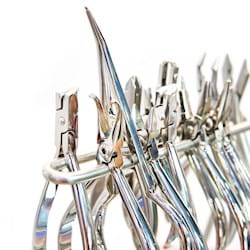BACKGROUND
A 56-year-old businessman Mr K is eating popcorn and fractures a post crown at UL5. He attends his dental surgery and is seen by his regular dentist Dr N who recements the crown in place.
Five months later Mr K makes an emergency appointment with severe pain and swelling in the upper left jaw. Dr N notes that UL5 is tender to percussion and mobile. A radiograph reveals an area of extensive pathology at UL5. Mr K opts to have the tooth extracted.
An appointment is made for later that day and during the extraction the root fractures. A further radiograph shows a 5mm root apex in close proximity to the maxillary sinus. Mr K is distressed and declines further surgical treatment. A review appointment is arranged.
A week later Mr K reattends the practice and Dr N irrigates and dresses the socket and in the subsequent months it heals well.
Mr K attends for a routine check-up a year later and asks Dr N about treatment options to address the gap at UL5. A decision is made to use UL4 as an abutment for a cantilever bridge.
A bridge is prepared and fitted and the occlusion adjusted in subsequent appointments.
Six months later Mr K returns to the surgery complaining of tenderness at UL4 when chewing. Dr N notes that UL4 is not tender to percussion and the occlusion appears to be satisfactory. Mr K is advised that if the problem persists root treatment may be necessary.
Mr K attends the practice again complaining of discomfort when biting on the bridge. Dr N notes tenderness when the pontic is percussed but not the abutment. A further radiograph is taken and Dr N judges that the small piece of root at UL5 is too far apically to cause the presenting symptoms.
A year later Mr K hears a crack when eating. On examination Dr N notes that the abutment (UL4) has fractured at gingival layer. A radiograph shows UL4 has a curved root and that the canals appear sclerosed.
Mr K is advised that RCT and post would be difficult. Dr N also notes that there has been cystic change around the small piece of root at UL5 and he advises specialist referral for surgical removal.
Mr K opts for RCT of UL4 having acknowledged the risks. The first part of the procedure proves difficult and Dr N notes the possibility of strip perforation having occurred. He dresses the tooth and informs Mr K that root treatment will be continued at the next visit but the prognosis for UL4 is uncertain.
Three days later Mr K returns to the surgery complaining of generalised pain in his upper left jaw. On examination Dr N finds UL4 tender to pressure and notes on removing the dressing blood is found in the canals. He again explains the problems with the root and the poor prognosis and extraction is advised.
A referral is made to an oral surgeon and UL4 is extracted along with the root fragment at UL5.
A solicitors letter is received by Dr N alleging clinical negligence in the care provided to Mr K. It is claimed that Dr N should have referred Mr K for extraction of the root fragment at UL5 before undertaking the bridgework – and this failure necessitated the need for RCT at UL4 which resulted in the subsequent root perforation and loss of tooth viability.
ANAYLYSIS/OUTCOME
An MDDUS dental adviser reviews the case along with a lawyer. An expert opinion is obtained from a specialist in restorative dentistry.
The expert comments that it is not uncommon for roots to fracture during extraction and that if the root fragment is small and symptom free it may be left in situ. Removal has to be balanced with the risk of causing further damage, particularly if in close proximity with the maxillary sinus. In this case the fragment was asymptomatic for an extended period of time with no radiographic signs of worsening pathology, and thus it was not unreasonable to carry out the bridgework without surgical extraction.
The expert further opines there is no basis to assume that the presence of the fragment at UL5 had any effect on the pulpal tissue within UL4 and the need for root treatment. Mr K was made aware of the particular risks (possible perforation with the curved root and sclerosed canal) before agreeing to RCT at UL4.
The expert concludes there is no breach of duty of care. Accordingly, it cannot be said that the failure of the bridgework and the loss of UL4 were caused by any actions on the part of Dr N.
A letter of response denying the allegations is drafted by MDDUS lawyers and the case is subsequently discontinued.
KEY POINTS
- Ensure that patients are fully engaged in decision making and understand treatment options proposed along with relevant potential risks.
- Clear and comprehensive clinical records are essential in defending against negligence claims.
- A clinician cannot be held liable if providing care that conforms to a standard reasonably expected of a competent practitioner.
This page was correct at the time of publication. Any guidance is intended as general guidance for members only. If you are a member and need specific advice relating to your own circumstances, please contact one of our advisers.
Save this article
Save this article to a list of favourite articles which members can access in their account.
Save to library



